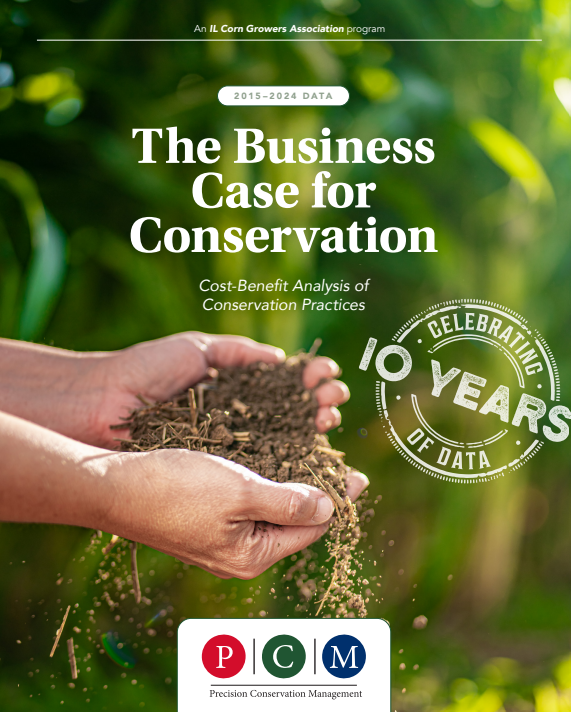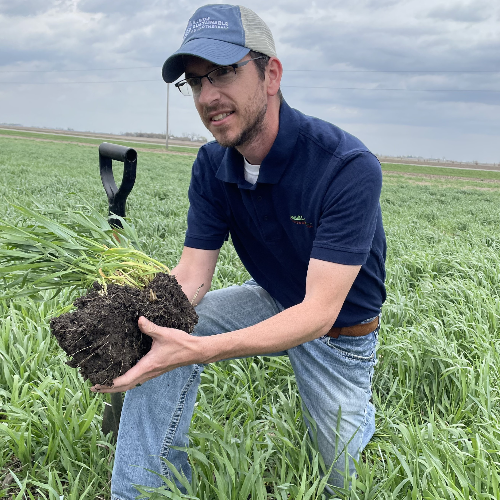Contributions by: Casey Kula, Greg Goodwin, and Jean Brokish
Cover crops have been suggested as a reliable tool to help the State of Illinois achieve goals identified in the Nutrient Loss Reduction Strategy (NLRS). In addition to acting as a nutrient scavenger, cover crops reduce soil erosion and provide carbon through biomass and root exudates that contributes to overall soil health of that system. A challenge to integrating cover crops is addressing the concerns that arise from potential yield drags or additional costs associated with cover crops that can reduce overall profit on a per acre basis.
To better understand the economic impact of cover crops in a corn-soybean rotation in Illinois, ISAP members invited Dr. Gary Schnitkey, an economist at the University of Illinois, to discuss the most recent grower data from Precision Conservation Management (PCM). Using ten year average data from 2015-2024 to see trends on high soil productivity rating soil (SPR), insights can be gained to inform producers on how to successfully introduce cover crops into their system as well as to optimize their system to achieve maximum benefit and minimal risk.

“The Business Case of Conservation” published by PCM summarizes profitability data from 10 years and thousands of acres across Illinois.
Start with Cover Crops Before Soybeans
When first adopting cover crops, starting before soybeans poses less risk to your profitability. There was negligible difference in overall yield in a cover crop compared to a no cover crop system before soybean. While promising, the system without cover crops provided a higher per acre profit, largely attributed to the cost of buying and planting cover crop seed. Some growers reported a reduction in pesticide use, but this reduction was not enough to offset establishment costs of the cover crops. Additionally, it is important that the cover crop does not interfere with the ability to get soybeans planted in April, which often works best in a no-till system.
From the data, using an overwintering cover crop before soybean offered a net return compared to the systems with no cover crop of -$71 to -$21. A winter terminal cover crop resulted in net returns of -$33 to +$27. In other words, PCM data do not show profitability of overwintering cover crops, but winter terminal cover crops have potential to be profitable when compared to a no cover crop system.
PCM (2015-2024) Average Net Return of Systems with Cover Crops on High SPR Soil Compared to No Cover Crop1 |
|||
|---|---|---|---|
| Cover Crop Type | Overwintering | Winter Terminal | No Cover Crop |
| Soybean | -$71 to -$21 | -$33 to +$27 | $0 |
| Corn | -$73 to -$23 | -$47 to +$3 | $0 |
Cover Crops Before Corn Requires Greater Management
Integrating cover crops into a system before a subsequent corn crop can provide challenges related to the nitrogen demand by corn. From the 2015-2024 High SPR dataset, we see that an overwintering and winter terminal cover crop resulted in a net return of -$73 to -$23 and -$47 to +$3, respectively, when compared to a no cover crop system. Management strategies are being researched and employed to try and close this gap. Establishing a healthy stand of clover and / or radish by planting into standing soybean has potential to provide additional nitrogen to the corn crop, although seed costs and difficulty of stand establishment are potential hurdles to making this option profitable. Using a winter-terminal cover crop could potentially work better before corn and is the recommended option for farmers getting started with cover crops before corn.
A Holistic Approach
Achieving your goals with a cover crop are important, and with proper attention, input costs can be reduced. Adequate stand establishment of cereal rye can provide the conservation benefits without breaking the bank when using an excessively high seeding rate. In most situations and with normal planting dates (mid-September – October in much of the state), 30-60 lbs/ac pure live seed (PLS) planted with a drill, or 40-70 lbs/ac PLS broadcast, will provide an adequate stand, according to the Midwest Cover Crop Council. Precision planting of cereal rye to skip the crop row can reduce seeding rate and potential interference with the subsequent cash crop while still providing conservation benefits.
In addition to reducing variable costs of pesticides or fertilizers through cover crop integration, producers can aim to reduce whole system costs by managing their fertility. Through increased organic matter and aggregation, regions with lower productivity soils may see a more prominent fertility benefit from cover crop management as compared to producers in higher productivity soils. High biomass cover crops can offer an opportunity for farmers to reduce costs on chemicals, while saving time, specifically through cutting back on the need or number of herbicide passes to control weeds. While weed suppression is an added bonus of cover crops, there is consideration to be made if the cover crop creates a habitat for other pests such as insects or fungi. If new to your cover crop journey, keeping biomass manageable to avoid interference with your cash crop is advised.

Cover crops like cereal rye reduce erosion and improve soil health.
Cover crops can be used to achieve much needed conservation benefits while closing the yield gap through long term soil health benefits and organic matter accumulation. Cover crops also have the potential to reduce the risk of yield penalty in commodity crops during drier or wetter years through building soil aggregation and increasing water infiltration as well as water holding capacity (Basche et al, 2016). Perhaps the greatest benefit of cover crops is their ability to reduce soil erosion. When compared to systems with no cover crops, overwintering cover crops reduce soil erosion by approximately 40%, and winter terminal cover crops reduce erosion by approximately 25%.
While it is difficult to assign dollar values to reduced soil erosion and better water infiltration, over time farmers reap economic benefits of better soil health. In the short term, farmers can also take advantage of cover crop related financial incentives, with payments ranging from $10-$65/acre. PCM’s report states that “It doesn’t take a large incentive payment to make cover crops a winning proposition.”
References
- Link to 2015-2024 PCM Business Case for Conservation: PCM-Data-Book-2025.pdf
- A.D. Basche et al. / Agricultural Water Management 172 (2016) 40–50
- Link to 2024 PCM Managing Risk with Cover Crops: https://www.precisionconservation.org/wp-content/uploads/2024/02/PCM-Cover-Crop-Guide-2024.pdf